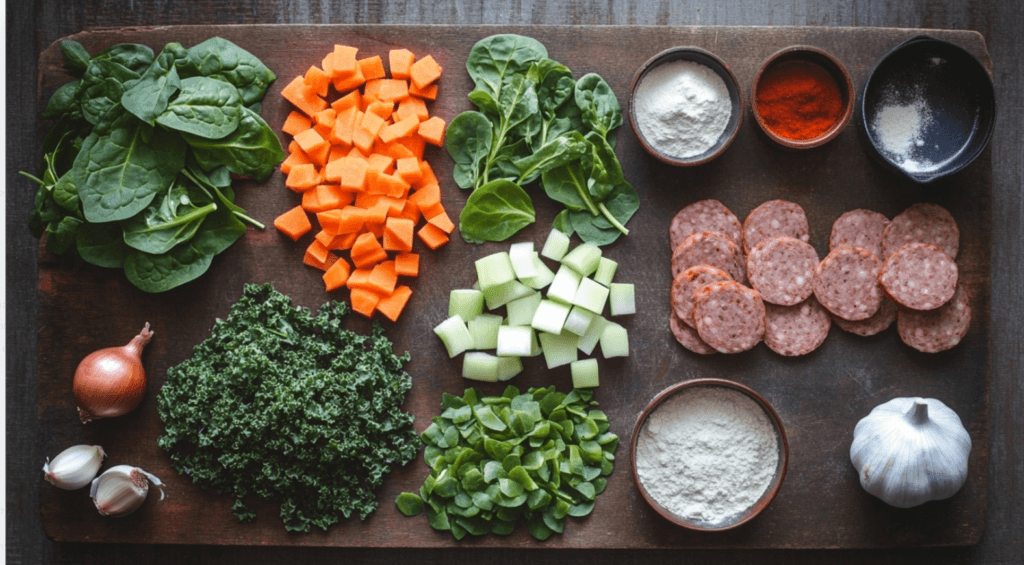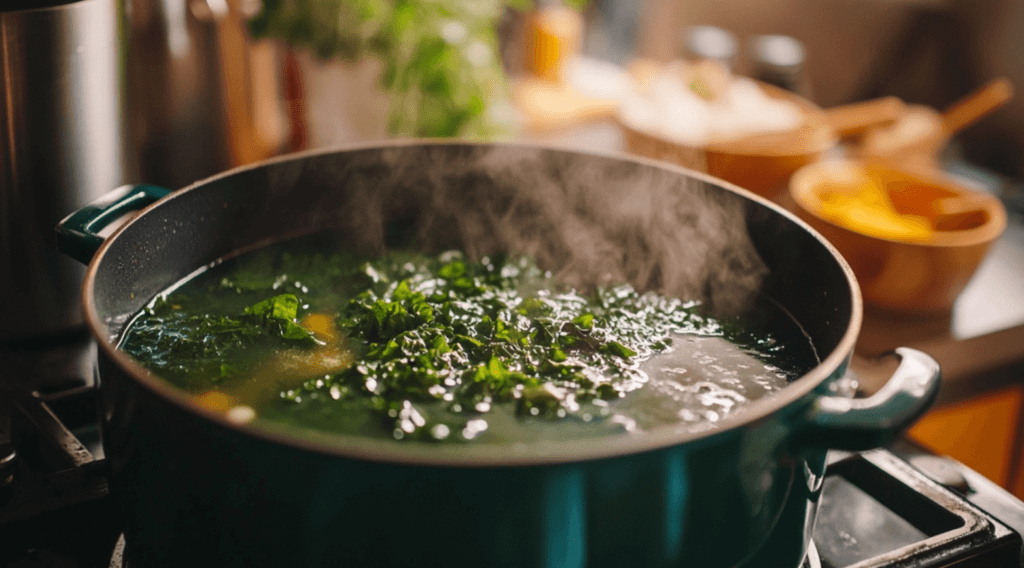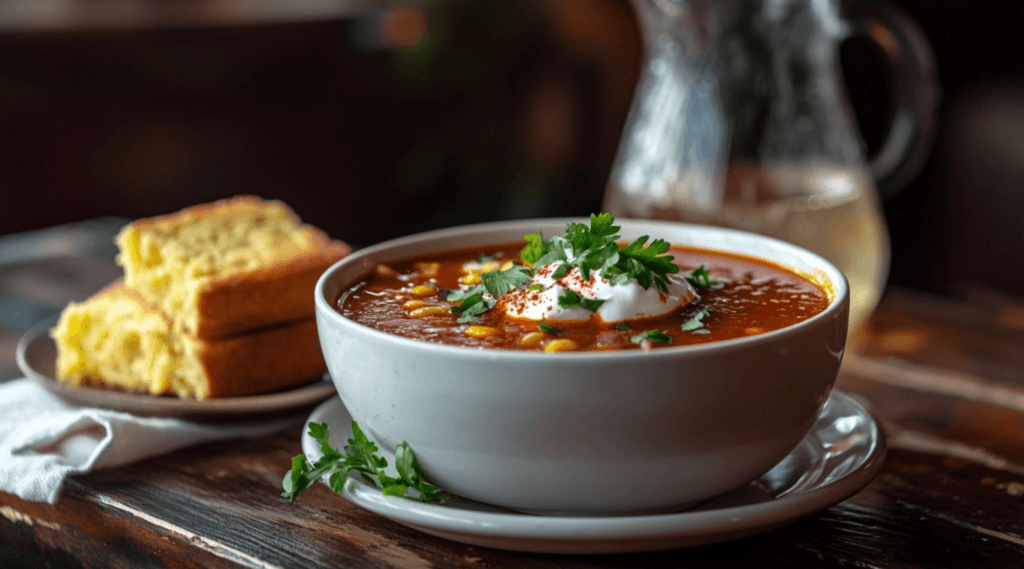Few dishes combine wholesome greens, savory broth, and comforting flavors as beautifully as a swamp soup recipe. This rustic, earthy soup gets its intriguing name from the vibrant, green hue imparted by hearty leafy vegetables and deep, simmered flavors. Although “swamp” might sound off-putting, the soup’s taste is anything but. Instead, it offers a rich, soothing meal that can be easily customized to fit a variety of dietary preferences, cooking styles, and regional twists.
In this article, you’ll discover everything you need to know to create your swamp soup recipe at home. From understanding the origins and appeal of this delicious green soup to exploring key ingredients, cooking techniques, variations, and nutrition tips, you’ll soon see why this comforting meal has been delighting cooks and eaters for generations. By the end, you’ll have a step-by-step guide, expert advice, and plenty of ideas for making the perfect bowl of swamp soup a recurring favorite in your household.
Understanding Swamp Soup
What Exactly Is Swamp Soup?
Swamp soup is a hearty, green-hued soup typically made by simmering leafy greens—such as spinach, kale, collard greens, or mustard greens—in a savory broth alongside aromatic vegetables and herbs. The greens release their natural color into the broth, resulting in an appearance reminiscent of a lush, verdant swamp, hence the dish’s name.
Though the color might be unusual, the flavor is mellow, rich, and comforting. A good swamp soup recipe balances sweetness from onions, carrots, or bell peppers; savory depth from proteins; and a gentle warmth from spices. This synergy produces a meal that’s both cozy and nutrient-rich, making it an appealing option for anyone seeking a wholesome, home-cooked dish.
Origins and Culinary Background of Swamp Soup
While the precise origins of swamp soup are not universally documented, it is often associated with Southern U.S. culinary traditions, as well as cuisines that value leafy greens as a staple ingredient. Certain versions have a Creole or Cajun influence, incorporating spices and smoked meats that reflect the cooking style of the American South. At the same time, global cuisines that emphasize dark, leafy greens—such as African, Mediterranean, or Asian traditions—may also inspire variations of a swamp soup recipe.
Over time, families and local restaurants have passed down their favorite twists on this comforting dish. You may find versions featuring regional greens, seasonal vegetables, or signature spices. The core idea remains a nourishing bowl of green goodness that warms both the body and the soul.
The Appeal of a Homemade Swamp Soup Recipe
One of the major draws of preparing swamp soup at home is the ability to control every aspect of its flavor and nutritional profile. Since it’s a flexible dish, you can easily adjust the ingredients to meet your dietary needs—whether you follow a vegetarian, vegan, or gluten-free diet. Another advantage is its affordability: leafy greens, common vegetables, and simple seasonings are often readily available, making swamp soup both budget-friendly and accessible.
This adaptability, combined with the soothing comfort that a warm bowl of soup provides, makes swamp soup an ideal choice for weeknight dinners, family gatherings, or even meal prepping in advance. Homemade versions often surpass store-bought soups in flavor complexity, freshness, and the personal touch that comes from cooking a dish with care.

Key Ingredients of a Swamp Soup Recipe
The Foundation: Leafy Greens and Vegetables
At the heart of any swamp soup recipe are the leafy greens that lend the dish its vibrant color and nutrient density. Common choices include spinach, kale, collard greens, and mustard greens. Each of these greens offers its own unique flavor profile: spinach is mild and slightly sweet, kale provides a robust, earthy taste, collards have a subtle bitterness, and mustard greens bring a peppery bite. Feel free to mix and match different greens to strike the perfect flavor balance.
Beyond greens, vegetables like onions, celery, garlic, and bell peppers form the aromatic base of the soup. These foundational flavors work in harmony, creating a savory starting point that is deepened further by broth, protein, and spices.
Proteins: From Sausage to Seafood
Protein choices in swamp soup vary widely. Smoked sausage, bacon, ham hocks, or Andouille sausage impart a smoky, savory depth, while seafood such as shrimp or crab can lighten the dish and add briny sweetness. For a plant-based version, tofu, tempeh, or even hearty mushrooms make excellent substitutes. Your protein selection depends on dietary preferences, desired richness, and the level of heartiness you want to achieve.
Broth and Seasonings
A rich and flavorful broth is the backbone of swamp soup. Chicken broth is common, but vegetable or seafood stock can also work beautifully. For a vegetarian or vegan swamp soup recipe, choose a quality vegetable broth that complements the greens without overpowering them.
Spices and herbs help define the soup’s character. Thyme, bay leaves, paprika, cayenne, and black pepper bring complexity and subtle warmth. A dash of hot sauce can add just the right amount of kick. Don’t forget to taste and adjust seasonings as the soup simmers—this ensures every spoonful bursts with flavor.
Optional Add-Ins for Texture and Flavor
For added heartiness, consider stirring in white beans, black-eyed peas, or chickpeas. These legumes provide extra protein and creaminess. If you like a more filling soup, add cooked grains such as rice or quinoa. Fresh herbs, a squeeze of lemon, or a splash of vinegar at the end can brighten and balance the deep, savory flavors.
Step-by-Step Swamp Soup Recipe Instructions
Before You Start: Prep and Kitchen Tools
The key to a smooth cooking process is proper preparation. Have a sharp knife, cutting board, and a large stockpot or Dutch oven ready. Chop your onions, celery, garlic, and other vegetables in advance. Rinse, dry, and chop your leafy greens before you begin. Keep broth, seasonings, and any proteins within easy reach. This mise en place approach ensures a stress-free cooking experience.
Detailed Swamp Soup Recipe Instructions
- Sauté Aromatics: Start by heating a splash of oil in your stockpot over medium heat. Add chopped onions, celery, and garlic. Stir until softened and fragrant, about 5 minutes.
- Add Proteins: If using smoked sausage, bacon, or another protein, add it now. Brown the pieces to develop flavor and render out any fat. Stir regularly to prevent sticking.
- Incorporate Greens: Begin adding your leafy greens in batches, allowing them to wilt slightly before adding more. This helps maintain control over the volume, as greens reduce significantly in size once they cook down.
- Pour in Broth: Once the greens have wilted, add your chosen broth. Pour enough to cover the ingredients generously. Bring the mixture to a gentle simmer.
- Seasoning: Stir in thyme, bay leaves, paprika, cayenne (if desired), salt, and pepper. Taste the broth and adjust seasonings incrementally. A small amount of hot sauce can be added at this stage for extra heat.
- Simmer and Cook Through: Reduce the heat to maintain a gentle simmer. Allow the soup to cook for at least 20-30 minutes, enabling the flavors to meld and the greens to become tender.
- Add Optional Beans/Grains: If using beans or cooked grains, stir them into the soup and allow them to heat through. This will thicken the soup slightly and create a more substantial meal.
- Finishing Touches: Once the flavors have developed, taste again and adjust seasonings. A splash of vinegar or a squeeze of lemon can provide brightness and balance. Don’t be afraid to experiment with a final pinch of herbs or a dash of your favorite hot sauce.
- Taste Test and Serve: Before ladling into bowls, make sure the soup has reached your desired level of seasoning, thickness, and tenderness. Once satisfied, serve hot and enjoy.
Cooking Times and Temperature Guidelines
Simmering is key to unlocking the full depth of flavor in swamp soup. Keep the temperature on low to medium-low, ensuring a gentle simmer rather than a rolling boil. This method preserves the integrity of the greens and avoids toughening proteins. Typically, 30-45 minutes of total cooking time is sufficient, though you can let it simmer longer for an even richer flavor.
Common Mistakes to Avoid
- Overcooking Greens: If simmered too long, greens can become overly soft or develop a bitter taste. Aim for a tender but not mushy texture.
- Underseasoning: Greens and broth need adequate seasoning. Taste frequently and adjust with salt, pepper, herbs, or acidity.
- Relying Solely on Salt: Balance is key. If the soup tastes flat, consider adding acidity (vinegar, lemon), heat (cayenne, hot sauce), or aromatic herbs instead of just more salt.

Variations and Substitutions
Vegan and Vegetarian Swamp Soup Recipe Options
For a plant-based version, skip the meat. Instead, choose mushrooms or smoked tofu for depth and heartiness. Vegetable broth, enriched with ingredients like nutritional yeast or miso paste, can replicate the savory intensity of meat-based versions. Add extra layers of flavor with spices like smoked paprika to achieve that crave-worthy richness without animal products.
Gluten-Free and Low-Carb Adaptations
If you’re following a gluten-free diet, opt for certified gluten-free broth and avoid grains containing gluten. Use beans or lentils as thickeners. For a low-carb approach, skip grains entirely and focus on extra veggies and proteins. Cauliflower rice is a great addition that provides a similar texture to grains without extra carbs.
Regional and Cultural Twists
- Creole-Style: Incorporate shrimp, crab, or Andouille sausage and a classic Holy Trinity of onion, celery, and bell pepper. Add cayenne and file powder for that authentic Louisiana flavor.
- Mediterranean Flair: Add chickpeas, olive oil, a pinch of cumin, and a squeeze of lemon. A sprinkling of fresh parsley or dill right before serving brings bright, sunny notes.
- Asian Inspiration: Stir in bok choy, ginger, and lemongrass. Finish with a splash of coconut milk and a drizzle of chili oil for a fragrant, creamy twist.
Serving Suggestions and Presentation Tips
How to Plate and Garnish Your Swamp Soup
Choose deep, wide bowls that showcase the soup’s gorgeous green hue. Garnishes can elevate your presentation: top with fresh herbs like parsley or cilantro, a swirl of sour cream or coconut cream, or crunchy croutons. A drizzle of chili oil or a dollop of pesto can add visual contrast and a pop of flavor.
Ideal Side Dishes
Serve your swamp soup with a side of warm cornbread, crusty sourdough bread, or fluffy biscuits to sop up the broth. A simple green salad or a tangy coleslaw can round out the meal. Consider setting out hot sauce, chili flakes, or herb-infused oils at the table for diners to customize their bowls.
Nutritional and Health Benefits
A Nutrient-Rich Meal
Leafy greens are nutritional powerhouses, rich in vitamins A, C, K, and a range of minerals like iron, magnesium, and calcium. Proteins and legumes add muscle-supporting amino acids and fiber. The overall nutritional profile of a swamp soup recipe can be quite balanced, especially if you use lean proteins and limit added fats.
Supporting a Balanced Diet
Because swamp soup features a variety of vegetables and greens, it can easily fit into health-conscious eating patterns. Adjust portion sizes depending on your nutritional goals. To keep sodium levels in check, use low-sodium broth and season gradually. If you need more protein, add a handful of beans or lean meats. For extra micronutrients, toss in additional vegetables or herbs.
Tips, Troubleshooting & Expert Advice
Tips for Perfecting Your Swamp Soup Recipe
- Taste as You Go: Adjust the seasoning as the soup simmers. Greens can mute flavors, so be prepared to enhance them with herbs, spices, or acidity.
- Experiment with Greens: Try different combinations of spinach, kale, and collards until you find your perfect balance.
- Better the Next Day: Swamp soup often tastes even better after resting overnight, allowing flavors to meld fully. Prepare a large batch and enjoy easy leftovers.
Troubleshooting Common Issues
- Too Salty: Add more broth or water to dilute, or stir in a starchy component like mashed beans.
- Too Thin: Let the soup simmer uncovered to reduce liquid, or add pureed vegetables or a cornstarch slurry.
- Lacking Flavor Depth: Try a splash of vinegar, a squeeze of lemon juice, or toasted spices to revive dull flavors.
Expert Insights and Pro Techniques
- Toast Your Spices: Briefly heating spices in oil before adding broth unlocks their aromatic potential.
- Use Homemade Stock: If possible, use a homemade stock to add layers of savory depth.
- Rest for Flavor: Allow the soup to rest off heat for 10-15 minutes before serving. This helps flavors settle and integrate.

Frequently Asked Questions (FAQs) about Swamp Soup Recipe
What is swamp soup made of?
Swamp soup typically consists of a blend of leafy greens (such as spinach, kale, or collards), a savory broth, and aromatics like onions, celery, and garlic. Additional components include protein (such as sausage, seafood, or tofu) and seasonings (such as thyme, paprika, or cayenne). The result is a hearty, nutrient-rich soup with a distinct green color.
Is swamp soup healthy?
Yes. With its ample leafy greens, lean proteins, and fiber-rich legumes or grains, swamp soup can be very nutritious. By selecting quality ingredients and balancing seasonings, you can create a soup that’s relatively low in calories yet high in vitamins, minerals, and antioxidants. Adjust the sodium and fat content by using low-sodium broth and lean proteins for an even healthier meal.
Can you freeze swamp soup?
Absolutely. Swamp soup freezes well. To preserve its quality, allow the soup to cool completely before transferring it to airtight containers. Store in the freezer for up to 2-3 months. Thaw in the refrigerator overnight before reheating gently on the stovetop.
How do you thicken swamp soup?
If your soup is too thin, you can thicken it in several ways. Add mashed beans, pureed vegetables, or a small amount of cornstarch mixed with water. Simmer the soup a bit longer to reduce excess liquid. Adjusting seasonings as you go will maintain flavor as you thicken.
What type of greens are best for swamp soup?
There’s no single “best” green; it depends on personal taste. Spinach is mild and sweet, kale is bold and earthy, collards have a subtle bitterness, and mustard greens add a peppery zing. Mix and match until you find a flavor profile that satisfies your palate.
Conclusion: Enjoying Your Homemade Swamp Soup Recipe
A well-crafted swamp soup recipe is more than just a meal—it’s a comforting embrace in a bowl. It combines the goodness of leafy greens, the savory depth of broth and proteins, and the subtle warmth of herbs and spices into an endlessly adaptable and delightfully nourishing dish.
Whether you want to expand your culinary repertoire, feed your family on a budget, or enjoy a comforting and healthy soup, swamp soup has much to offer. Don’t hesitate to experiment, adjust, and refine the recipe to match your tastes. Soon enough, this green wonder will become a household favorite, cherished for its flavor, nutrition, and soul-warming satisfaction.

